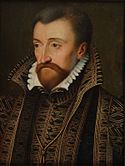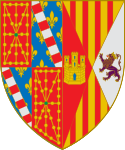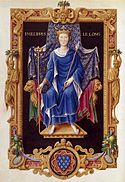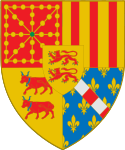Władcy Nawarry

Dynastia Jimenez
| # | Imię | Urodzony | Zmarł | Czas rządów | Rodzice | |
|---|---|---|---|---|---|---|
| 1 | Inigo Arista Íñigo Arista |  | ok. 790 | 851 | 824–851 | Inigo Jimenez Oneca |
| 2 | Garcia Iniguez García Íñiguez | 810 | 880 | 851–880 | Inigo Arista Oneca Velazquez | |
| 3 | Fortun Jednooki Fortún el Tuerto | 830 | 906 | 880–905 | Garcia Iniguez Urraka Jimenez | |
| 4 | Sancho I Sancho I | ok. 860 | 11 grudnia 925 Resa | 905–926 | Garcia Jimenez Dadildis de Bigorra | |
| 5 | Garcia I García I | 919 | 22 lutego 970 | 926–970 | Sancho I (król Nawarry) Toda de Larraun | |
| 6 | Sancho II Sancho II | 935 | grudzień 994 | 970–994 | Garcia I (król Nawarry) Andregota Galindez | |
| 7 | Garcia II Tchórz García II el Temblón | ok. 964 | 1000 | 994–1000 | Sancho II (król Nawarry) Urraka Fernandez | |
| 8 | Sancho III Wielki Sancho III el Grande |  | ok. 985 Oviedo | 18 października 1035 | 1000–1035 | Garcia II Tchórz Jimena Fernandez |
| 9 | Garcia III García III | 1020 | 15 września 1054 Atapuerca | 1035–1054 | Sancho III Wielki Muniadona | |
| 10 | Sancho IV Sancho IV | ok. 1039 | 4 czerwca 1076 Penalen | 1054–1076 | Garcia III (król Nawarry) Stefania de Foix | |
| 11 | Sancho V Sancho V |  | ok. 1042 | 4 czerwca 1094 Huesca | 1076–1094 | Ramiro I (król Aragonii) Ermesinda z Bigorre |
| 12 | Piotr I Pedro I |  | ok. 1068 | 27 września 1104 Vall d'Aran | 1094–1104 | Sancho Ramírez Izabela d'Urgel |
| 13 | Alfons I Waleczny Alfonso I el Batallador |  | ok. 1073 | 7 września 1134 San Juan de la Pena | 1104–1134 | Sancho Ramírez Felicja de Roucy |
| 14 | Garcia IV Odnowiciel García IV el Restaurador | 1110 | 21 listopada 1150 Lorca | 1134–1150 | Ramiro Sánchez, pan Monzón Cristina Rodriguez Diaz de Vivar | |
| 15 | Sancho VI Mądry Sancho VI el Sabio | ok. 1133 | 27 czerwca 1194 Pampeluna | 1150–1194 | Garcia IV Odnowiciel Małgorzata de l'Aigle | |
| 16 | Sancho VII Mocny Sancho VII el Fuerte |  | 1160 | 7 kwietnia 1234 Tudela | 1194–1234 | Sancho VI Mądry Sancha Kastylijska |
Dynastia z Szampanii
| # | Imię | Urodzony | Zmarł | Czas rządów | Rodzice | |
|---|---|---|---|---|---|---|
| 17 | Tybald I Trubadur Teobaldo I el Trovador |  | 30 maja 1201 Troyes | 8 lipca 1253 Pampeluna | 1234–1253 | Tybald III (hrabia Szampanii) Blanka z Nawarry |
| 18 | Tybald II Młody Teobaldo II el Joven | 1238 | 4 grudnia 1270 Trapani | 1253–1270 | Tybald I Trubadur Małgorzata de Dampierre | |
| 19 | Henryk I Gruby Enrique I el Gordo | 1244 | 22 lipca 1274 Pampeluna | 1270–1274 | Tybald I Trubadur Małgorzata de Dampierre | |
| 20 | Joanna I Juana I |  | 14 stycznia 1273 Bar-sur-Seine | 2 kwietnia 1305 Vincennes | 1274–1305 | Henryk I Gruby Blanka d’Artois |
Kapetyngowie
| # | Imię | Urodzony | Zmarł | Czas rządów | Rodzice | |
|---|---|---|---|---|---|---|
| 21 | Filip I Piękny Felipe IV el Hermoso | 1268 Fontainebleau | 29 listopada 1314 Fontainebleau | 1284–1305 | Filip III Śmiały Izabela Aragońska | |
| 22 | Ludwik I Kłótliwy Luis I el Turbulento |  | 4 października 1289 Paryż | 5 czerwca 1316 Vincennes | 1305–1316 | Filip IV Piękny Joanna I z Nawarry |
| 23 | Jan I Pogrobowiec Juan I el Póstumo |  | 15 listopada 1316 Vincennes | 20 listopada 1316 Vincennes | 1316 | Ludwik I Kłótliwy Klemencja Węgierska |
| 24 | Filip II Długi Felipe II el Largo |  | 17 listopada 1293 Lyon | 3 stycznia 1322 Longchamp | 1316–1322 | Filip IV Piękny Joanna I z Nawarry |
| 25 | Karol I Piękny Carlos I el Hermoso |  | 18 czerwca 1294 Creil | 1 lutego 1328 Vincennes | 1322–1328 | Filip IV Piękny Joanna I z Nawarry |
| 26 | Joanna II Mała Juana II | 28 stycznia 1311 Conflans | 6 października 1349 Conflans | 1328–1349 | Ludwik I Kłótliwy Małgorzata Burgundzka |
- Związki rodzinne władców Francji, Anglii i Nawarry w XIII i XIV w.
Dynastia Evreux
| # | Imię | Urodzony | Zmarł | Czas rządów | Rodzice | |
|---|---|---|---|---|---|---|
| 27 | Filip III Felipe III |  | 27 marca 1306 | 16 września 1343 Jerez de la Frontera | 1328–1343 | Ludwik d'Évreux Małgorzata de Conches |
| 28 | Karol II Zły Carlos II el Malo | 10 października 1332 Evreux | 1 stycznia 1387 Pampeluna | 1349–1387 | Filip III d'Evreux Joanna II Mała | |
| 29 | Karol III Szlachetny Carlos III el Noble | 1361 Mantes | 8 września 1425 Olite | 1387–1425 | Karol II Zły Joanna de Valois | |
| 30 | Blanka I Blanca I | 1391 | 3 kwietnia 1441 Segovia | 1425–1441 | Karol III Szlachetny Eleonora Kastylijska |
Dynastia Trastamara
| # | Imię | Urodzony | Zmarł | Czas rządów | Rodzice | |
|---|---|---|---|---|---|---|
| 31 | Jan II Juan II |  | 29 czerwca 1397 Medina del Campo | 20 stycznia 1479 Barcelona | 1425–1479 | Ferdynand I Sprawiedliwy Eleonora de Albuquerque |
| 32 | Eleonora I Leonor I | 2 lutego 1425 | 12 lutego 1479 Tudela | 1479 | Jan II Aragoński Blanka I z Nawarry |
Dynastia Foix
| # | Imię | Urodzony | Zmarł | Czas rządów | Rodzice | |
|---|---|---|---|---|---|---|
| 33 | Franciszek Febus Francisco Febo | ok. 1469 | 29 stycznia 1483 Pau | 1479–1483 | Gaston de Foix, książę Viana Magdalena de Valois | |
| 34 | Katarzyna I Catalina I | 1468 | 12 lutego 1518 Mont-de-Marsan | 1483–1518 | Gaston de Foix, książę Viana Magdalena de Valois |
Dynastia Albret
| # | Imię | Urodzony | Zmarł | Czas rządów | Rodzice | |
|---|---|---|---|---|---|---|
| 35 | Jan III Juan II | 1469 | 14 czerwca 1516 Pau | 1484–1516 | Alain d’Albret Franciszka de Chatillon | |
| 36 | Henryk II Enrique II |  | 24 kwietnia 1503 Sanquesa | 25 maja 1555 Pau | 1516–1555 | Jan III d’Albret Katarzyna de Foix |
| 37 | Joanna III Juana III |  | 7 stycznia 1528 Saint-Germain-en-Laye | 9 czerwca 1572 Paryż | 1555–1572 | Henryk II d’Albret Małgorzata d’Angoulême |
Burbonowie
| # | Imię | Urodzony | Zmarł | Czas rządów | Rodzice | |
|---|---|---|---|---|---|---|
| 38 | Antoni I Antonio I |  | 22 kwietnia 1518 La Fère | 17 listopada 1562 Les Andelys | 1555–1562 | Karol de Burbon-Vendôme Franciszka d'Alençon |
| 39 | Henryk III Enrique III |  | 13 grudnia 1553 Pau | 14 maja 1610 Paryż | 1572–1610 | Antoni de Burbon-Vendôme Joanna III d’Albret |
| 40 | Ludwik II Luis II |  | 27 września 1601 Fontainebleau | 14 maja 1643 Saint-Germain-en-Laye | 1610–1620 (1643) | Henryk III Maria Medycejska |
Królestwo Nawarry zostało związane z Francją unią personalną w 1589, zaś w 1620 r. zostało formalnie włączona do Francji. Tytuł króla Nawarry zachował się jednak w tytulaturze francuskich władców, aż do obalenia monarchii w 1791. Został też przywrócony w okresie restauracji 1814–1830.
Zobacz też
Media użyte na tej stronie
Léonard Limosin: Henri d'Albret (1503–1555), King of Navarre (mid-16th century), Metropolitain Museum of Art
Związki ostatnich Kapetyngów z Plantangenetami - poszerzona wersja schematu z francuskiej wiki
Portrait de Jean II le Bon dans le Recueil des rois de France.
Autor: Miguillen, Licencja: CC BY-SA 3.0
Escudo de Armas de Juan II como rey de Navarra. Según el blasón: 1.º Cuartelado de Navarra y Evreux. 2.º Cuartelado en aspa de Aragon, Castilla y León. Fuente: "El escudo de armas de Navarra" de Faustino Menéndez Pidal y Navascués y Javier Martínez de Aguirre, Editado en 2000 Por el Departamento de Presidencia, Justicia e Interior del Gobierno de Navarra, ISBN 84-235-2016-1
Portrait au crayon de Jeanne d'Albret, reine de Navarre. Recueil. Portraits dessinés de la Cour de France.
Autor: Miguillen, Licencja: CC BY 3.0
Armas de los reyes de Navarra de la dinastía de los Capetos (1284-1328), que también fueron reyes de Francia. El Escudo es partido con las armas de Francia (De azur y un sembrado de flores de lis) y las de Navarra. y Corresponde al que se usó en los sellos como rey de Navarra
Retrato imaginario del rey Pedro I de Aragón († 1104), que fue hijo del rey Sancho Ramirez de Aragón y de la reina Isabel de Urgel.
Autor: Miguillen, Licencja: CC BY 3.0
Armas de los reyes de Navarra de la dinastía Albret-Foix
Retrato imaginario del rey Sancho Ramírez de Aragón († 1094), que fue hijo del rey Ramiro I de Aragón y de la reina Gisberga.
Autor:
- Grand Royal Coat of Arms of France & Navarre.svg: Sodacan / praca pochodna: Sodacan
Grand Coat of Arms of France and Navarre: from 1589 to 1790. From the ascension of Henry III of Navarre as Henry IV of France (first King of the House of Bourbon) to the changing of Louis XVI's title as King of France and Navarre to King of the French. (heraldry and coat of arms having been abolished in France 1790). *The Coat of Arms contains two escutcheons; per pale: "Azure, three fleurs-de-lis or" for the France and "Gules, a cross, saltire, (double) orle of chains, all linked, or'" for Navarre. *The escutcheons are surrounded first by the chain of the Order of Saint Michael and by the chain of the Order of the Holy Spirit, both were known as the ordres du roi. * Atop the escutcheons is the Royal crown on top of an opened gold helmet, with blue mantling. *The two supporters are two angels, acting as heralds for the two realms. The dexter angel carries a standard with the arms of France, and wearing a tabard with the same arms. The sinister angel also carries a standard and wears a tabard, but that of Navarre. Both are standing on puffs of cloud. *Above is a pavilion armoyé with the Royal Crown of France. From it is a royal blue mantle with a semis of fleurs-de-lis or *On top of the crown is a representation of the sacred oriflamme, or the war banner of France, raised by the King only in times of great danger. *The motto is written in gold on a blue ribbon: "MONTJOIE SAINT DENIS" the war cry of France, Saint Denis was also the abbey where the oriflamme was kept. [1]
Autor: Ipankonin, Licencja: CC-BY-SA-3.0
Coat of arms the Kingdom of Navarre
Blazon: Gules, a cross, saltire, and orle of chains linked together Or, a centre point vert.Joan I of Navarre
Autor: Miguillen, Licencja: CC BY 3.0
Escudo de armas de los reyes de Navarra de la dinastía Foix
Modern statue of medieval king Philip the IIIth, located in Pamplona. It was sculpted as a part of the iconographic program of the Royal Palace of Madrid, ordered by Fray Martín Sarmiento.
Theobald IV of Champagne
Autor: User:Miguillen, Licencja: CC BY-SA 4.0
Escudo de Armas de los reyes de Navarra de la dinastía de Champaña
Autor: Oryginalnym przesyłającym był Rafaelji z hiszpańskiej Wikipedii, Licencja: CC-BY-SA-3.0
es:Sancho el Fuerte de Navarra, vidriera en es:Roncesvalles.
Autor es:Rafaelji. Diapositiva 35 mm. Tomada en agosto de 1989.Autor: Luis García (Zaqarbal), Licencja: CC-BY-SA-3.0
Statue of Íñigo I of Pamplona (c.781–852) at the Plaza de Oriente (square) in Madrid (Spain). Sculpted in white stone by José Oñate between 1750 and 1753.
Autor: Juan Rizi , Licencja: CC-BY-SA-3.0
Retrato de Don Sancho el Mayor
Retrato imaginario del rey Juan II de Aragón (1398-1479), que fue hijo del rey Fernando I de Aragón y de la reina Leonor de Alburquerque.
Autor: Miguillen, Licencja: CC BY 3.0
Armas de los reyes de Navarra de la dinastía Evreux segúen el blasón: Escudo cuartelado 1.º y 4.º de Navarra, En campo de gules unas cadenas de oro puestas en orla cruz y sotuer con una esmeralda en el abismo y 2.º y 3.º de Evreux. En campo de azur, un sembrado de flores de lis de oro con una cotiza formada por seis piezas de plata y gules.
Retrato imaginario del rey Alfonso I de Aragón († 1134), que fue hijo del rey Sancho Ramírez y de la reina Felicia de Roucy.



































